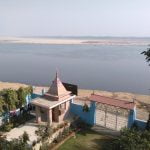Introduction
Discover the Attractive Difference between kashi and varanasi to ancient Scriptures and mythplogy.
Kashi and Varanasi are two names for the same ancient city located on the banks of the River Ganges in Uttar Pradesh, India. Kashi is the traditional and historical name, meaning “City of Light,” which dates back to ancient Hindu scriptures and mythology. It was considered the spiritual capital of ancient India. Varanasi, derived from the names of two rivers – Varuna and Assi, became the more commonly used name during the medieval period. While both names refer to the identical geographical location, Kashi is more closely associated with the city’s spiritual and religious significance, whereas Varanasi is the modern official name used for administrative and political purposes. The city is also sometimes called Benares, a name given during the British colonial period.
Difference between kashi and varanasi

Historical Evolution: Kashi’s Ancient Name Versus Modern Varanasi’s Cultural Identity
Difference between kashi and varanasi :
The distinction between Kashi and Varanasi represents more than a mere change in nomenclature; it embodies the transformation of one of India’s most sacred cities through different historical epochs. Kashi, derived from the Sanskrit word ‘Kash’ meaning ‘to shine,’ represents the city’s ancient identity as a spiritual beacon that has illuminated Hindu consciousness for millennia. This original name reflects the city’s primordial character as a center of learning, spirituality, and cultural excellence.
Throughout its extensive history, Kashi has been known by various names, each reflecting different aspects of its identity and the historical periods it traversed. The name Varanasi, which gained prominence in later periods, originates from its geographical location between two rivers: the Varuna and the Assi. This newer designation emphasizes the city’s physical attributes and its strategic positioning along the banks of the holy Ganges River.
The transition from Kashi to Varanasi mirrors the city’s evolution from a purely spiritual center to a multifaceted urban entity. While Kashi predominantly represented the city’s religious and philosophical dimensions, Varanasi emerged as a name that encompassed its broader cultural, commercial, and social aspects. This evolution reflects the city’s adaptation to changing times while maintaining its spiritual core.
In ancient texts and religious literature, Kashi is frequently mentioned as ‘Avimukta,’ meaning ‘never forsaken,’ referring to the belief that Lord Shiva never abandons this sacred place. This religious significance associated with the name Kashi continues to resonate deeply with pilgrims and spiritual seekers who view the city as a gateway to moksha (liberation). Conversely, Varanasi represents the city’s more contemporary identity, incorporating its role as a center of arts, crafts, music, and education.
The cultural implications of both names are significant. Kashi evokes images of ancient wisdom, spiritual practices, and philosophical traditions that have been preserved for generations. It represents the city’s timeless essence and its role as a keeper of sacred knowledge. Meanwhile, Varanasi symbolizes the city’s dynamic nature, its ability to embrace change while maintaining its traditional character, and its significance in modern India’s cultural landscape.
The coexistence of both names in contemporary usage reflects the city’s dual identity. While official documents and modern references typically use Varanasi, the name Kashi continues to be used in religious contexts and traditional practices. This duality perfectly captures the city’s ability to exist simultaneously in different temporal and cultural dimensions.
The transformation from Kashi to Varanasi also reflects broader historical changes in Indian society. As the city evolved from a primarily religious center to a modern urban space, the name Varanasi became more prevalent, though without diminishing the spiritual significance associated with Kashi. This evolution demonstrates how ancient cities can adapt to contemporary needs while preserving their historical essence.
Today, both names serve distinct yet complementary purposes in understanding and experiencing the city. Kashi remains the eternal city of light and liberation, while Varanasi represents its contemporary avatar, where ancient traditions seamlessly blend with modern life. This dual identity has enabled the city to maintain its relevance across centuries while preserving its sacred character, making it a unique example of cultural continuity in an ever-changing world.
Religious Significance: Kashi’s Spiritual Legacy Compared to Varanasi’s Contemporary Practices
Difference Between Kashi and Varanasi: Religious Significance: Kashi’s Spiritual Legacy Compared to Varanasi’s Contemporary Practices
The religious significance of Kashi and Varanasi presents an intriguing study in both historical continuity and evolutionary change within sacred geography. While these names refer to the same physical location, they represent distinct temporal and spiritual dimensions of this ancient city’s identity. Kashi, the more ancient name, embodies the eternal, metaphysical aspect of the sacred site, while Varanasi represents its contemporary manifestation and living traditions.
In the context of spiritual significance, Kashi is often referred to as the “City of Light” or “The Luminous One,” representing the cosmic center of Shiva’s universe according to Hindu mythology. This eternal aspect of the city transcends physical boundaries and time itself, existing as what scholars term the “celestial Kashi.” The concept of Kashi extends beyond mere geographical coordinates to encompass a realm where spiritual liberation is guaranteed, as described in ancient Sanskrit texts and the Puranas.
The spiritual practices associated with Kashi are deeply rooted in Vedic traditions and philosophical understanding. The city’s sacred geography is mapped through a complex network of temples and shrines, with the Kashi Vishwanath Temple serving as its spiritual nucleus. This ancient understanding of Kashi emphasizes the city’s role as a tirtha, or crossing point, between the material and spiritual realms, where the boundaries between earth and heaven become permeable.
In contrast, Varanasi represents the living, breathing manifestation of these ancient principles in contemporary times. The modern city maintains many traditional practices while adapting to present-day realities. The ghats of Varanasi, while maintaining their sacred character, now accommodate both religious rituals and tourist activities. The daily evening Ganga Aarti ceremony exemplifies this blend, combining ancient ritual practices with modern organizational methods to accommodate large crowds of both devotees and visitors.
The religious practices in contemporary Varanasi have evolved to include new forms of worship and celebration while preserving core spiritual principles. Modern-day priests and pandas (religious guides) continue ancient traditions but have adapted their services to meet the needs of present-day pilgrims. The city has also become a center for religious education and cultural studies, with institutions like Banaras Hindu University bridging the gap between ancient wisdom and modern scholarship.
Despite these distinctions, the relationship between Kashi and Varanasi is not one of opposition but of complementarity. The eternal Kashi continues to exist as a spiritual ideal and source of divine energy, while Varanasi serves as its earthly manifestation, making sacred traditions accessible to contemporary practitioners. This dynamic interaction between the timeless and the temporal creates a unique spiritual ecosystem where ancient wisdom and modern practice coexist and enrich each other.
The enduring significance of both aspects of the city lies in their ability to maintain continuity while adapting to change. Whether referred to as Kashi or Varanasi, the city remains a powerful symbol of Hindu spirituality, demonstrating how ancient religious traditions can remain relevant and vital in the modern world while preserving their essential sacred character. This dual identity continues to attract millions of pilgrims and seekers who find in its lanes and ghats both the eternal promise of spiritual liberation and the living practice of faith.
Geographical Boundaries: Understanding Where Ancient Kashi Ends and Modern Varanasi Begins
Difference Between Kashi and Varanasi: Geographical Boundaries: Understanding Where Ancient Kashi Ends and Modern Varanasi Begins
The geographical demarcation between ancient Kashi and modern Varanasi presents an intriguing study in urban evolution and sacred geography. While these names often refer to the same city, their boundaries and spiritual significance carry distinct historical and cultural implications that have evolved over millennia.
Ancient Kashi, traditionally considered the spiritual heart of the city, encompasses a more concentrated area primarily centered around the Vishwanath Temple and the main ghats along the Ganges River. This sacred zone, known as the Panch Koshi Parikrama, extends approximately five kos (about 15 kilometers) in radius from the Vishwanath Temple. According to Hindu scriptures, this area represents the cosmic center where Lord Shiva is believed to have first appeared as a column of light.
In contrast, modern Varanasi extends far beyond these traditional boundaries, incorporating newer developments and suburban areas that have emerged over time. The contemporary city spans approximately 82 square kilometers and includes various administrative divisions, commercial centers, and residential neighborhoods that were not part of the original Kashi landscape.
The transition between ancient Kashi and modern Varanasi is most evident in the architectural and urban planning patterns. The old city, representing historical Kashi, is characterized by narrow, winding lanes (galis), ancient temples, and traditional housing structures that follow a medieval pattern of urban development. These areas maintain their original character with buildings dating back several centuries and streets that barely accommodate modern vehicles.
Moving outward from this core, the city gradually transforms into modern Varanasi, where wider roads, contemporary buildings, and planned developments become increasingly prevalent. This expansion has been particularly noticeable in areas such as Lanka, Banaras Hindu University campus, and the Cantonment area, which represent the modern face of the city while maintaining connections to its spiritual heritage.
The geographical distinction is further emphasized by the different administrative and functional roles these areas serve. While ancient Kashi primarily functions as a spiritual and cultural center, focusing on religious activities and traditional practices, modern Varanasi encompasses educational institutions, industrial areas, and commercial zones that cater to contemporary urban needs.
The Ganges River serves as a natural boundary and unifying element between the old and new sections of the city. The western bank, where most of the ancient ghats are located, represents traditional Kashi, while the eastern bank and inland areas showcase the expansion of modern Varanasi.
Understanding these geographical boundaries is crucial for both urban planning and heritage conservation efforts. While development continues to push the city’s boundaries outward, careful consideration is given to preserving the sacred geography of ancient Kashi. This balance between preservation and progress has resulted in a unique urban landscape where centuries-old traditions coexist with modern amenities.
The distinction between Kashi and Varanasi, therefore, is not merely nominal but represents a complex interplay of sacred geography, urban development, and cultural evolution. As the city continues to grow and evolve, these boundaries may shift, but the essential character of both ancient Kashi and modern Varanasi remains preserved in their respective geographical domains.
Q&A
1. Kashi and Varanasi are the same city?
Kashi is the ancient name, while Varanasi is the modern name. The city was also known as Benares during British colonial rule.
2. Kashi refers specifically to the spiritual and religious aspects of the city meaning
“City of Light,” while Varanasi derives its name from the rivers Varuna and Assi that flow through it.
3. Kashi appears more frequently in ancient Hindu texts and spiritual contexts
while Varanasi is the official name used in modern administration, government documents, and contemporary references.
Conclusion
Kashi and Varanasi are the same city, with Kashi being its ancient name and Varanasi its modern name. Kashi means “City of Light” and represents the city’s spiritual significance in ancient texts, while Varanasi derives from the names of two rivers – Varuna and Assi. Both names are used interchangeably to refer to this holy city on the banks of the Ganges River, with Kashi generally being used in religious and traditional contexts, while Varanasi is the official name used in administrative and contemporary settings.







